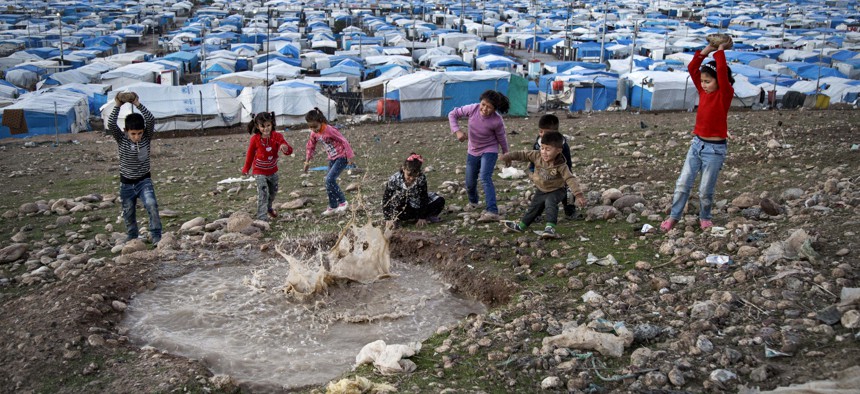
In this Saturday, Nov. 28, 2015 photo, Syrian refugee children play at a temporary refugee camp in Irbil, northern Iraq. AP Photo/Seivan M. Salim
US Considers Using Portable DNA Labs, Iris Scans to Vet Syrian Refugees
Throughout the Syrian civil war the UN has relied on portable eye-scanning machines to register fleeing Syrians, but the US has yet to make use of that data.
The U.S. government is considering a handful of new technologies to strengthen and potentially hasten the screening of Syrian refugees.
Mobile DNA analyzers and iris-recognition systems are among the tools under consideration or recently deployed, as the Obama administration strives to let in thousands of individuals escaping Bashar al-Assad's regime and keep out terrorists.
Meanwhile, partners at the United Nations are scouring social media posts to verify the circumstances of people claiming to be Syrian refugees.
The U.S. Refugee Admissions Program is planning to pilot an initiative, in cooperation with the UN, to use iris scans collected by the UN’s refugee agency, according to the Department of Homeland Security.
Throughout the Syrian civil war, the UN High Commissioner for Refugees, or UNHCR, has relied on portable eye-scanning machines to register the identities of fleeing Syrians, but the United States has not made use of the highly reliable biometric data. That may change.
In the pilot with UNHCR, iris-matching tools will verify applicants’ identities when they appear for their resettlement interviews with U.S. officials, according to DHS.
Another trial program involves "rapid DNA" desktop-size labs.
Processing cheek swabs from children and accompanying adults, which is required to prevent child trafficking, can take weeks.
There are new machines that enable any DHS employee to run a test and confirm a match in about 60 minutes. But the department last year delayed a scheduled field test until consent paperwork and language differences could be hashed out.
Both the iris and rapid DNA pilot projects are in the planning stages, according to DHS.
“We are constantly looking for ways to make the process as efficient as possible without cutting corners on security,” said DHS spokesman Daniel Cosgrove.
President Barack Obama in September committed to allowing 10,000 Syrian refugees into the country, when confronted with a backlog of 23,092 cases referred by UNHCR. The United States has accepted around 2,000 Syrian refugees since 2011.
But ever since a fraudulent Syrian passport was found near the body of one of the Paris attackers in November, the screening process for Syrian refugees has come into question.
Questions about immigration security checks, in general, multiplied earlier this month, when a husband and wife shot 14 people dead at an office holiday party in San Bernardino, California. The woman, Tashfeen Malik, cleared multiple U.S. background checks to obtain a fiancée visa. Early media reports indicated that Malik had posted social media messages declaring support for jihad, although FBI Director James Comey said today the attackers sent only private online messages that wouldn't have been spotted by U.S. officials.
It was only in the last year that Homeland Security began several pilots to add "appropriate social media” evaluations into its assessments for certain immigrant categories, DHS spokeswoman Marsha Catron said. She declined to specify whether refugees are one of the test populations.
"The department is actively considering additional ways to incorporate the use of social media review in its various vetting programs," Catron said in a statement emailed to reporters.
UNHCR, usually the first stop on any Syrian's years-long journey to legal U.S. refugee status, already consults social media during initial interviews to confirm an applicant's story.
The agency relies on open source information, including Google searches and public social media posts, because the agency typically does not have access to classified government information, said Larry Yungk, UNHCR senior resettlement officer.
"Just as a minimum, we plug in variations of names on the Internet. And you surprisingly find sources very quickly," said Yungk, whose three-person office coordinates programs for 27 countries. "We don't have the intelligence capacity of the NSA or the CIA."
During UNHCR interviews, as a refugee communicates personal information, the interviewee might, for example, enter the applicant's original home address into Google Earth to make sure the location exists. Or if a refugee claims to have lived in a town hit by military strikes, the UN staffer might run an online news search to see if there was an actual bombing in the town when the individual fled.
The appeal of iris scanning technology is similar to that of Internet access at UNHCR.
"We have gone to this technology frankly because we are in the field all the time," Yungk said. "Fingerprinting requires technique and trained operators."
At UNHCR interviews, refugees step in front of what looks like a toy View-Master, which captures an image of their irises, scrambles it with encryption technology, and then sends it to a remote database server for matching. The process takes seconds, Yungk said. The applicant's eyes are scanned during each encounter with the agency up until when the individual is referred to the United States.
The screening is done "to make sure that we have a continuity of identity," Yungk said. "Is this the same person who registered on this date? If someone came in at the very beginning and gave you the wrong data that would be maintained until the time the person gets fingerprints taken" by the United States.
The UN database catalogs the irises of about 1.64 million individuals, largely from Syria, he said. Typically, only the eyes of individuals age 7 and up are scanned because iris patterns change as children grow, Yungk said.
In June, the U.S. government began automating the process of checking an applicant's biographical data, continuously, between the initial overseas interview and arrival in the United States, according to DHS. "Recurrent vetting" cross-checks a refugee's information against multiple agency watch lists and other potentially derogatory data.
"DHS believes this change will yield a significant improvement because it reduces or eliminates the need to resubmit interagency checks," Cosgrove said.
A State spokeswoman said in an email the department "continues to make improvements" that are "focused on process efficiency" to its Worldwide Refugee Admissions Processing System, a key computer program that records refugee biographies and monitors the progress of an applicant from referral to entrance into the United States.
When a would-be U.S. settler reaches the DHS interview phase, Homeland Security staff begins biometric checks using mobile fingerprint equipment and photographs to save time, according to DHS.
The department's biometric database is tied to a massive FBI "Next-Generation Identification" system, which can recognize faces, palms, fingerprints and irises.
Privacy groups are paying close attention to the growing use of iris pattern and rapid DNA collections in the federal government. A key concern, evidenced by multiple open records requests, is a lack of transparency into how the data is stored, who it is shared with, and for what exact purposes.
Homeland Security has tinkered with iris-matching at southwest border stations on and off in recent years. Just this month, DHS Customs and Border Protection activated iris-scanning kiosks at the Otay Mesa pedestrian crossing to verify who enters and exits the United States.
"Iris is an excellent modality, but it hasn't reached mainstream law enforcement yet," Janice Kephart, former counsel on the 9/11 Commission and now a Security Identity and Biometrics Association board member, said of the UN refugee eye-scanning effort. "Screening against it might not yield much, but you have to start somewhere" to build a database.
